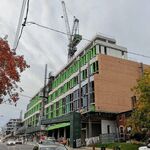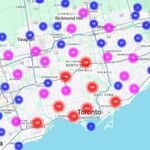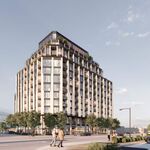I would like to use some real world examples to compare with.
The T here in Pittsburgh (a high quality LRT line that turns into a subway downtown) has several lines, and from my station at Castle Shannon's Willow stop, you have two options since the lines come together at that point.
You can take the Mt Lebanon-Beechview line on the 42 trains that runs through very urban territory and crosses many city street intersections and runs inside of traffic, not even separated in its own lane, for about 1km.
Second option is a more express train on the Overbrook line, and the 47 trains that run on this line have "express stops," no traffic mixing and no signals to contend with. By express stops I mean there are only 8 stations between downtown and Castle Shannon as opposed to the many stops on the Mt Lebanon-Beechview line where stops can be spaced less than 100 meters apart at times.
The entire length between Castle Shannon and downtown's 1st Ave station is approximately 10km, or 6 miles.
It takes me 21-23 minutes to get downtown on the 47 trains via the express oriented Overbrook line, if I chose to get on a 42 train and go through Mt Lebanon and Beechview, it takes 29-30 minutes.
You can do the calculations yourself, but for the same distance the express subway-speed 47 trains only gain 8 minutes for 10 km.
I don't think the speed will be nearly as bad as some people think, the Mt Lebanon-Beechview line doesn't even run in suburban streets, it crosses several very urban districts right in the street where traffic commonly backs up, and runs in traffic for a short part.
Here is a map to help you visualize everything. I live near the Willow stop in downtown Castle Shannon, and I have a choice to take and commonly switch out between the 42 and 47 trains. Usually the wait for the next train is longer than if I just hop on a 42 train.
Pittsburgh has a very unique system, because some very old traditional streetcar lines were incorporated into the system. The 52 train runs in traffic up in the Allentown community, and it runs entirely in traffic, yet it is retrofitted to use only modern LRT cars.
On the map above, both the 52 Allentown service (which is limited service) and the 42 trains have sections that run through traffic. If you look at the 42 trains, the section between Potomac station and Fallowfield station is the in-street portion.
And if you're still not too confused, the large dots are platform stations where you enter at any door, and there are usually fare booth attendants, especially during rush hour. The small dots are low level platforms where you only can enter at the front of the train and have to pay the driver.
So in order to travel 10km, on the Overbrook line it takes approx. 22 minutes, and in traffic it takes 29 minutes.










